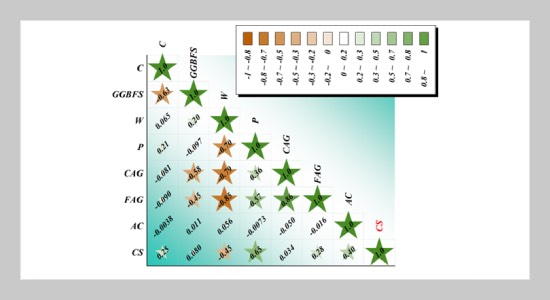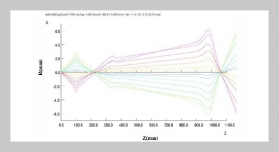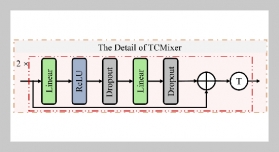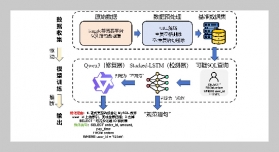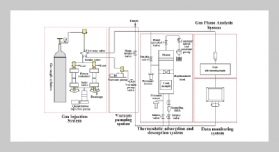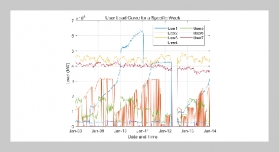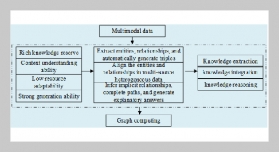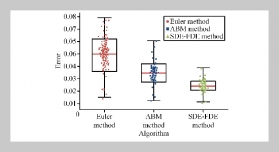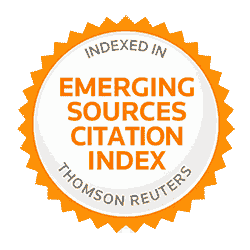- [1] R. S. Benemaran, M. Esmaeili-Falak, and M. S. Kord lar, (2024) “Improvement of recycled aggregate concrete using glass fiber and silica fume" Multiscale and Multidisciplinary Modeling, Experiments and Design 7: 1895–1914. DOI: https: //doi.org/10.1007/s41939-023-00313-2.
- [2] L. Chen and W. Jiang, (2023) “Estimation of the Com pressive Strength of Self-Compacting Concrete (SCC) by a Machine Learning Technique Coupling with Novel Optimization Algorithms" Advances in Engineering and Intelligence Systems 2: 38–49. DOI: https://doi.org/10.22034/aeis.2023.383263.1069.
- [3] B. P. Lenka, R. K. Majhi, S. Singh, and A. N. Nayak, (2022) “Eco-friendly and cost-effective concrete utilizing high-volume blast furnace slag and demolition waste with lime" European Journal of Environmental and Civil Engineering 26: 5351–5373. DOI: https: //doi.org/10.1080/19648189.2021.1896581.
- [4] R. K. Majhi, A. N. Nayak, and B. B. Mukharjee, (2020) “Characterization of lime activated recycled aggregate concrete with high-volume ground granulated blast furnace slag" Construction and Building Materials 259: 119882. DOI: https://doi.org/10.1016/j.conbuildmat.2020.119882.
- [5] B. P. Lenka, R. K. Majhi, S. Singh, and A. N. Nayak, (2022) “Eco-friendly and cost-effective concrete utilizing high-volume blast furnace slag and demolition waste with lime" European Journal of Environmental and Civil Engineering 26: 5351–5373. DOI: https: //doi.org/10.1080/19648189.2021.1896581.
- [6] R. K. Majhi, A. N. Nayak, and B. B. Mukharjee, (2020) “Characterization of lime activated recycled aggregate concrete with high-volume ground granulated blast furnace slag" Construction and Building Materials 259: 119882. DOI: https: //doi.org/10.1016/j.conbuildmat.2020.119882.
- [7] V. Revilla-Cuesta, M. Skaf, A. Santamaría, J. M. Romera, and V. Ortega-López, (2022) “Elastic stiffness estimation of aggregate–ITZ system of concrete through matrix porosity and volumetric considerations: explana tion and exemplification" Archives of Civil and Mechanical Engineering 22: 59. DOI: https://doi.org/ 10.1007/s43452-022-00382-z.
- [8] V.Revilla-Cuesta, F. Faleschini, C. Pellegrino, M. Skaf, and V. Ortega-López, (2022) “Simultaneous addition of slag binder, recycled concrete aggregate and sustain able powders to self-compacting concrete: a synergistic mechanical-property approach" journal of materials research and technology 18: 1886–1908. DOI: https: //doi.org/10.1016/j.jmrt.2022.03.080.
- [9] R. K. Majhi and A. N. Nayak, (2019) “Bond, durability and microstructural characteristics of ground granulated blast furnace slag based recycled aggregate concrete" Construction and Building Materials 212: 578–595. DOI: https: //doi.org/10.1016/j.conbuildmat.2019.04.017.
- [10] V. Ortega-López, V. Revilla-Cuesta, A. Santamaría, A. Orbe, and M. Skaf, (2022) “Microstructure and dimensional stability of slag-based high-workability concrete with steelmaking slag aggregate and fibers" Journal of Materials in Civil Engineering 34: 04022224. DOI: https: //doi.org/10.1061/(ASCE)MT.1943-5533.0004372.
- [11] G. Leon and H.-L. Chen, (2021) “Thermal analysis of mass concrete containing ground granulated blast furnace slag" Civil Eng 2: 254–270. DOI: https: //doi.org/10.3390/civileng2010014.
- [12] X.-Y. Wang, H.-S. Lee, K.-B. Park, J.-J. Kim, and J. S. Golden, (2010) “A multi-phase kinetic model to simulate hydration of slag–cement blends" Cement and Concrete Composites 32: 468–477. DOI: https: //doi.org/10.1016/j.cemconcomp.2010.03.006.
- [13] B. Boukhatem, M. Ghrici, S. Kenai, and A. Tagnit Hamou, (2011) “Prediction of efficiency factor of ground granulated blast-furnace slag of concrete using artificial neural network" ACI Materials Journal 108: 55. DOI: http: //worldcat.org/oclc/13846872.
- [14] A. Mohammed, L. Burhan, K. Ghafor, W. Sarwar, and W. Mahmood, (2021) “Artificial neural network (ANN), M5P-tree, and regression analyses to predict the early age compression strength of concrete modified with DBC-21 and VK-98 polymers" Neural Computing and Applications 33: 7851–7873. DOI: https: //doi.org/10.1007/s00521-020-05525-y.
- [15] F. Masoumi, S. Najjar-Ghabel, A. Safarzadeh, and B. Sadaghat, (2020) “Automatic calibration of the ground water simulation model with high parameter dimensionality using sequential uncertainty fitting approach" Water Supply20: 3487–3501. DOI: https://doi.org/10.2166/ ws.2020.241.
- [16] M.Esmaeili-Falak and R. S. Benemaran, (2024) “Ap plication of optimization-based regression analysis for evaluation of frost durability of recycled aggregate con crete" Structural Concrete 25: 716–737. DOI: https: //doi.org/10.1002/suco.202300566.
- [17] A. A. Shahmansouri, H. A. Bengar, and S. Ghanbari, (2020) “Compressive strength prediction of eco-efficient GGBS-based geopolymer concrete using GEP method" Journal of Building Engineering 31: 101326. DOI: https: //doi.org/10.1016/j.jobe.2020.101326.
- [18] I. Nunez, A. Marani, M. Flah, and M. L. Nehdi, (2021) “Estimating compressive strength of modern concrete mixtures using computational intelligence: A systematic review" Construction and Building Materi als 310: 125279. DOI: https: //doi.org/10.1016/j.conbuildmat.2021.125279.
- [19] A. Gogineni, I. K. Panday, P. Kumar, and R. kr Paswan, (2024) “Predictive modelling of concrete com pressive strength incorporating GGBS and alkali using a machine-learning approach" Asian Journal of Civil Engineering 25: 699–709. DOI: https: //doi.org/10.1007/s42107-023-00805-z.
- [20] C. Bilim, C. D. Ati¸s, H. Tanyildizi, and O. Karahan, (2009) “Predicting the compressive strength of ground granulated blast furnace slag concrete using artificial neu ral network" Advances in Engineering Software 40: 334–340. DOI: https: //doi.org/10.1016/j.advengsoft.2008.05.005.
- [21] A. Kandiri, E. M. Golafshani, and A. Behnood, (2020) “Estimation of the compressive strength of concretes containing ground granulated blast furnace slag using hybridized multi-objective ANN and salpswarm algorithm" Construction and Building Materials 248: 118676. DOI: https: //doi.org/10.1016/j.conbuildmat.2020.118676.
- [22] S. Czarnecki, M. Shariq, M. Nikoo, and Ł. Sadowski, (2021) “An intelligent model for the prediction of the com pressive strength of cementitious composites with ground granulated blast furnace slag based on ultrasonic pulse velocity measurements" Measurement 172: 108951. DOI: https: //doi.org/10.1016/j.measurement.2020.108951.
- [23] H. Nhat-Duc, (2023) “Estimation of the compressive strength of concretes containing ground granulated blast furnace slag using a novel regularized deep learning approach" Multiscale and Multidisciplinary Modeling, Experiments and Design 6: 415–430. DOI: https: //doi.org/10.1007/s41939-023-00154-z.
- [24] M. Sarıdemir, ˙ I. B. Topçu, F. Özcan, and M. H. Severcan, (2009) “Prediction of long-term effects of GGBFS on compressive strength of concrete by artificial neural networks and fuzzy logic" Construction and Building Materials 23: 1279–1286. DOI: https: //doi.org/10.1016/j.conbuildmat.2008.07.021.
- [25] I.-J. Han, T.-F. Yuan, J.-Y. Lee, Y.-S. Yoon, and J.-H. Kim, (2019) “Learned prediction of compressive strength of GGBFS concrete using hybrid artificial neural network models" Materials 12: 3708. DOI: https: //doi.org/10.3390/ma12223708.
- [26] L. Burhan, K. Ghafor, and A. Mohammed, (2019) “Modeling the effect of silica fume on the compressive, tensile strengths and durability of NSC and HSC in various strength ranges" Journal of Building Pathology and Rehabilitation 4: 1–19. DOI: https: //doi.org/10.1007/s41024-019-0058-4.
- [27] N.S.Piro,A.S.Mohammed,andS.M.Hamad,(2023) “Evaluate and predict the resist electric current and com pressive strength of concrete modified with GGBS and steelmaking slag using mathematical models" Journal of Sustainable Metallurgy 9: 194–215. DOI: https://doi.org/10.1007/s40831-022-00631-8.
- [28] N. S.Piro, A. S. Mohammed, and S. M. Hamad,(2022) “The impact of GGBS and ferrous on the flow of electrical current and compressive strength of concrete" Construction and Building Materials 349: 128639. DOI: https: //doi.org/10.1016/j.conbuildmat.2022.128639.
- [29] N. S. Piro, A. Mohammed, S. M. Hamad, and R. Kurda, (2023) “RETRACTED ARTICLE: Artificial neural networks (ANN), MARS, and adaptive network-based fuzzy inference system (ANFIS) to predict the stress at the failure of concrete with waste steel slag coarse aggregate re placement" Neural Computing and Applications 35: 13293–13319. DOI: https: //doi.org/10.1007/s00521-023-08439-7.
- [30] P. Y. Saleh, D. K. I. Jaf, A. A. Abdalla, H. U. Ahmed, R. H. Faraj, W. Mahmood, and A. S. Mohammed, (2023) “Prediction of the compressive strength of strain hardening cement-based composites using soft comput ing models" Structural Concrete 24: 6761–6777. DOI: https: //doi.org/10.1002/suco.202200769.
- [31] W. Emad, A. S. Mohammed, R. Kurda, K. Ghafor, L. Cavaleri, S. M. A. Qaidi, A. M. T. Hassan, and P. G. Asteris. “Prediction of concrete materials compressive strength using surrogate models”. In: Structures. 46. Elsevier, 2022, 1243–1267. DOI: https: //doi.org/10.1016/j.istruc.2022.11.002.
- [32] Q. Sun, (2024) “Artificial rabbit optimization-based AN FIS model development for predicting the compressive strength of GGBFS-based concrete" Structural Concrete 25: 334–348. DOI: https: //doi.org/10.1002/suco.202300508.
- [33] Z. Xiaozhen and X. Le, (2023) “Estimating the com pressive strength of GGBFS-based concrete employing optimized regression analysis" Journal of Intelligent & Fuzzy Systems 45: 6535–6547. DOI: https://doi.org/10.3233/JIFS-233428.
- [34] A. Oner and S. Akyuz, (2007) “An experimental study on optimum usage of GGBS for the compressive strength of concrete" Cement and concrete composites 29: 505 514. DOI: https: //doi.org/10.1016/j.cemconcomp.2007.01.001.
- [35] M. Shariq, J. Prasad, and A. Masood, (2010) “Effect of GGBFS on time dependent compressive strength of concrete" Construction and Building Materials 24: 1469 1478. DOI: https: //doi.org/10.1016/j.conbuildmat.2010.01.007.
- [36] J. Benesty, J. Chen, Y. Huang, and I. Cohen. Noise reduction in speech processing. 2. Springer Science & Business Media, 2009. DOI: https: //doi.org/10.1007/978-3-642-00296-0.
- [37] M. Khishe and M. R. Mosavi, (2020) “Chimp optimization algorithm" Expert systems with applications 149: 113338. DOI: https: //doi.org/10.1016/j.eswa.2020.113338.
- [38] F. A. Hashim, E. H. Houssein, K. Hussain, M. S. Mabrouk, and W. Al-Atabany, (2022) “Honey Bad ger Algorithm: New metaheuristic algorithm for solving optimization problems" Mathematics and Computers in Simulation 192: 84–110. DOI: https: //doi.org/10.1016/j.matcom.2021.08.013.
- [39] G. James, D. Witten, T. Hastie, and R. Tibshirani. An introduction to statistical learning. 112. Springer, 2013. DOI: https: //doi.org/10.1007/978-3-031-38747-0.
- [40] A. Liaw and M. Wiener, (2002) “Classification and regression by random Forest" R news 2: 18–22. DOI: http: //CRAN.R-project.org/doc/Rnews/.
- [41] N. Donges, (2019) “A complete guide to the random forest algorithm" Built in 16:
- [42] D. Li, X. Zhang, Q. Kang, and E. Tavakkol, (2023) “Estimation of unconfined compressive strength of marine clay modified with recycled tiles using hybridized extreme gradient boosting method" Construction and Building Materials 393: 131992. DOI: https: //doi.org/10.1016/j.conbuildmat.2023.131992.
- [43] M.Esmaeili-Falak and R. S. Benemaran, (2024) “En semble extreme gradient boosting based models to predict the bearing capacity of micropile group" Applied Ocean Research 151: 104149. DOI: https: //doi.org/10.1016/j.apor.2024.104149.
- [44] H.Kou, J. Quan, S. Guo, and E. Hassankhani, (2024) “Light and normal weight concretes shear strength estimation using tree-based tunned frameworks" Construc tion and Building Materials 452: 138955. DOI: https: //doi.org/10.1016/j.conbuildmat.2024.138955.
- [45] K. Zhang, Y. Zhang, and B. Razzaghzadeh, (2024) “Application of the optimal fuzzy-based system on bearing capacity of concrete pile" Steel and Composite Structures 51: 25–41. DOI: https://doi.org/10.12989/scs.2024.51.1.025.
- [46] Y.Dawei,Z.Bing,G.Bingbing, G.Xibo, andB.Razza ghzadeh, (2023) “Predicting the CPT-based pile set-up parameters using HHO-RF and PSO-RF hybrid mod els" Structural Engineering and Mechanics, An Int’l Journal 86: 673–686. DOI: https: //www.dbpia.co.kr/pdf/cpViewer.
- [47] B. M. Yaychi and M. Esmaeili-Falak, (2024) “Estimating axial bearing capacity of driven piles using tuned random forest frameworks" Geotechnical and Geological Engineering 42: 7813–7834. DOI: https://doi.org/10.1007/s10706-024-02952-9.
- [48] A.R. T. Khangah, E. Khajavi, H. Azizi, and A. R. A. Novin, (2024) “Radial Basis Function Coupling with Metaheuristic Algorithms for Estimating the Compressive Strength and Slump of High-Performance Concrete" Advances in Engineering and Intelligence Systems 3: 124–142. DOI: https: //doi.org/10.22034/aeis.2024.483670.1241.


